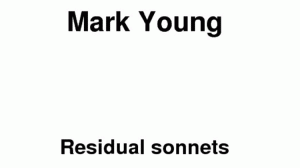The Tethered Ground by Lanette Cadle / Woodley Press / 2019 / 978-0998700366 / 102 pages

“You wanna fly, you got to give up the shit that weighs you down.”
—Toni Morrison, Song of Solomon
The Tethered Ground is Lanette Cadle’s first full-length poetry collection, and Cadle knows where she comes from—Kansas, a land of “Soft clouds, hard times,” where “Stars hang heavy in the sky.” A reckoning of place, “Clouds shaped like anvils” portend the gravity inherent in this collection, where “Kansas demands and Kansas takes what people have.” Still, wrestling with the terrestrial is a weight Cadle knows is better borne together, and because she is so masterful in her craft, the result is a set of poems that manages to connect us along the ley lines, from her homeland of Kansas to our shared territory here on Earth.
Gravity, how heavy it feels to be human, is central throughout the collection. There are tires that “need replacing” that “you can smell the burnt edges after they stop” (Poem with a Broken Heart in the Middle of It). Taking place in five acts, the structure of the book is an inquiry into how this gravity affects all, from our decidedly human experiences to the brutality of the animal kingdom. Slugs, turtles, lemmings with “purpose,” “bullfrog chirp” and “catfish slap,” the music of nature, gives way to “A snail shell empty, blown to the curb,” “all ashes, ashes, just not yet” (After). At the end of the day, Cadle knows the cyclical nature of the corporeal, and she uses herself as tribute: “I’m the one in your way, the one//moving slow, legs held up by pain” (Staring at the Future). Embodiment becomes a study in the realization that life on earth is often a pained existence that is “deep, bone-deep” (The Cure).
The poems oscillate between reverence for, and disappointment with, home, the irony of being tied to place as tug of war between feeling tied down or feeling safe. One of my favorite poems of the collection appears in “Through the Window,” where the author begins:
“Lavender must be cut back to the roots each fall to keep it
from choking the bulbs come spring.”
and speaks of her six-month-old son:
“I lost heart the year I became a mother
and let it stay tall for winter sparrows and cardinals
clustered against the constant wind.”
And there is that connection; a new mother losing heart results in an untended yard, a haven for birds trying to survive a harsh Midwestern winter. “Becoming a mother/ wasn’t supposed to be like this” (“The Cure). In The Tethered Ground, there are struggles happening on both sides of the fence. What connects us is a sense of hope:
“and that’s who I need, someone with dreams, but practical
to help rebuild this ground and shout to the universe
that we planned this and the death underground is just temporary.” (Everything Dies)
What lifts the whole residence off its foundation is a kind of world-weary hope—realistic, a sidelong sighing glance of hope that knows the word is trite, but what else do we have? Let’s call it Midwestern.
There is another kind of gravity at work here, simultaneously, one of watching places you loved in towns now abandoned, isolated. There is a kind of midwestern mourning watching a place die and decay. In “Cartography” amidst places with names like El Dorado and Walnut Creek Farm, the wear and ruin pervades “just another vacant space across from a vacant space across from the squatty cylinders and spires of the refinery.” In Provenance, “True Midwesterners/ give directions by what isn’t there.” To be from the Midwest is to know what it is like to love ghosts.
The precariousness of a life lived in flyover states allows for The Tethered Ground’s moments of study in ruin to become a celebration: the loss of the old ways is great tragedy, and the Midwest’s railroad town abandon is devastating and holy, all at once. Cadle is unafraid to tell us that the idiosyncratic beauty of a place is often earned by surviving it: “I live where trees grow/without irrigation and hills don’t have to be marked Hillside Street/to be noticed.” Above all, The Tethered Ground reveres the real and the hard-scrabble, with whip-smart observation of place and razor-sharp assessment of its potential and pitfalls.
Birds are often totems, augury for new signs of life, in this collection. Cadle does quite a bit of taking the auspices in The Tethered Ground, and this divination of birds in flight underscores our inability to do the same; what Cadle explores in this collection is an esoteric battle between both the metaphoric and too-real heaviness of our lives and the weightlessness we crave. As symbols, the birds are not always good omens, and their freedom mocks us at times in The Tethered Ground.
This feeling follows the narrator through it all. In “Broken Sonnet with Birds,”
“He needs that luck. His outdoor cat got hit
by lightning just last March. I think the birds
did it. I don’t know how.”
All of this is our tethered ground, the one we kiss out of relief once the tornado has gone. This is what keeps us connected to the earth, makes space for cycles of spring, summer, gives way to fall of winter, allows, accepts, lives, survives. “There is/ no springing back when nothing dies” (False Spring) and “The world is in stasis, a small insistence that even blades of grass need/ time to wither.” (Poem Coated with the First Frost). In “Eclipse,” Cadle begins with an epigraph by Astrologer Susan Miller, and “even when you’re a Virgo and don’t believe,” it is clear she feels a deep connection to the earth and a sense of justice surrounding it. Classic Virgo.
In “Human,” Cadle writes:
“To be human is to be animal; it is
to be a flightless bird”
And who wouldn’t have dreams of flying, hailing from Tornado Alley?
It is in the midst of this grappling, however, that this collection lifts off the ground. In the title poem, the author reveals:
“As a child, I let Kansas winds toss me into the air,
that pudgy body no more than a dry leaf. It was like flyingfor just a moment and when I fall asleep, I feel that still,
a lightness of the soul without the body.”
Still, this book reminds me less of the Midwest, and the tornados we, as children, excitedly sheltered from underground, and more of a woman and all the things we hold—all the things we hold onto that inevitably hold us down. For instance, in “Three Moons,” the author writes, “men grow up with words less slippery, words/that don’t slide from my hands into the water/ and splash my face.” A professor of rhetoric, Cadle weaves in nods to the rhetorical and the semiotic, and for her, writing is a terrestrial act, one filled with noticing: “When writing, the small things/count” (Inchworm). For this poet, listening is a rhetorical act. The author deeply understands that art requires a sense of nuance, and one cannot force the lightning strike down the tree.
If you listen, the earth will reveal her true name to you, and she does in Cadle’s The Tethered Ground. This book reminds us of our interdependence, and that responsibility to our shared earth should hang heavy around our necks right now, that this tethered ground that holds us is both cradle and grave, and that to be stewards of the earth is an honor. In terms of her reverence for the natural world—a Mary Oliver for heavier times—Cadle, amid her imagery of flights and birds, tornados and flowers, yanks that tethered rope, the silver cord that ties us to this terrible and awesome waking life and reminds us to be grateful, for however much longer we can. This book grapples with the weight of it all, defying gravity in its ascent.





Leave a Reply